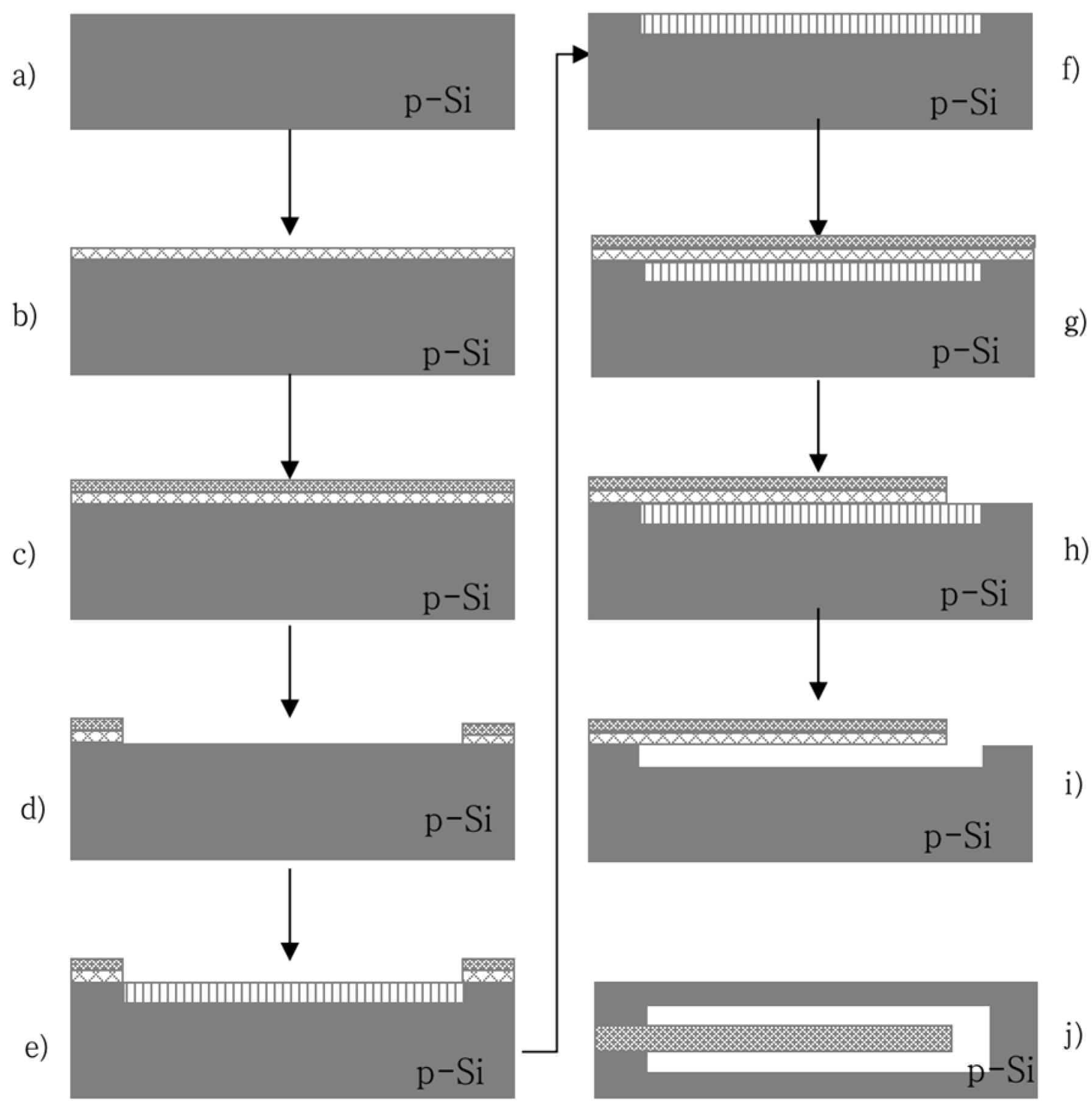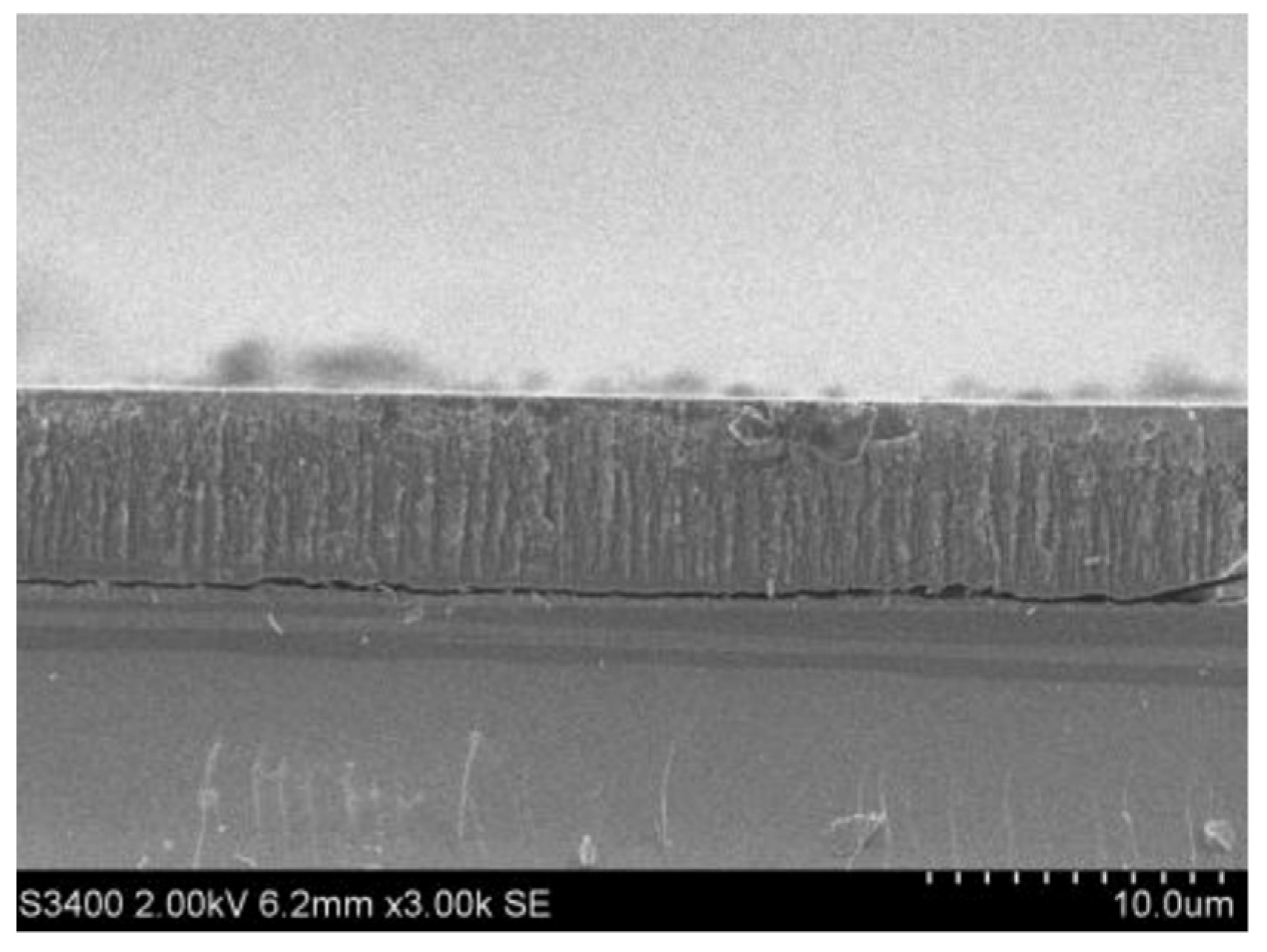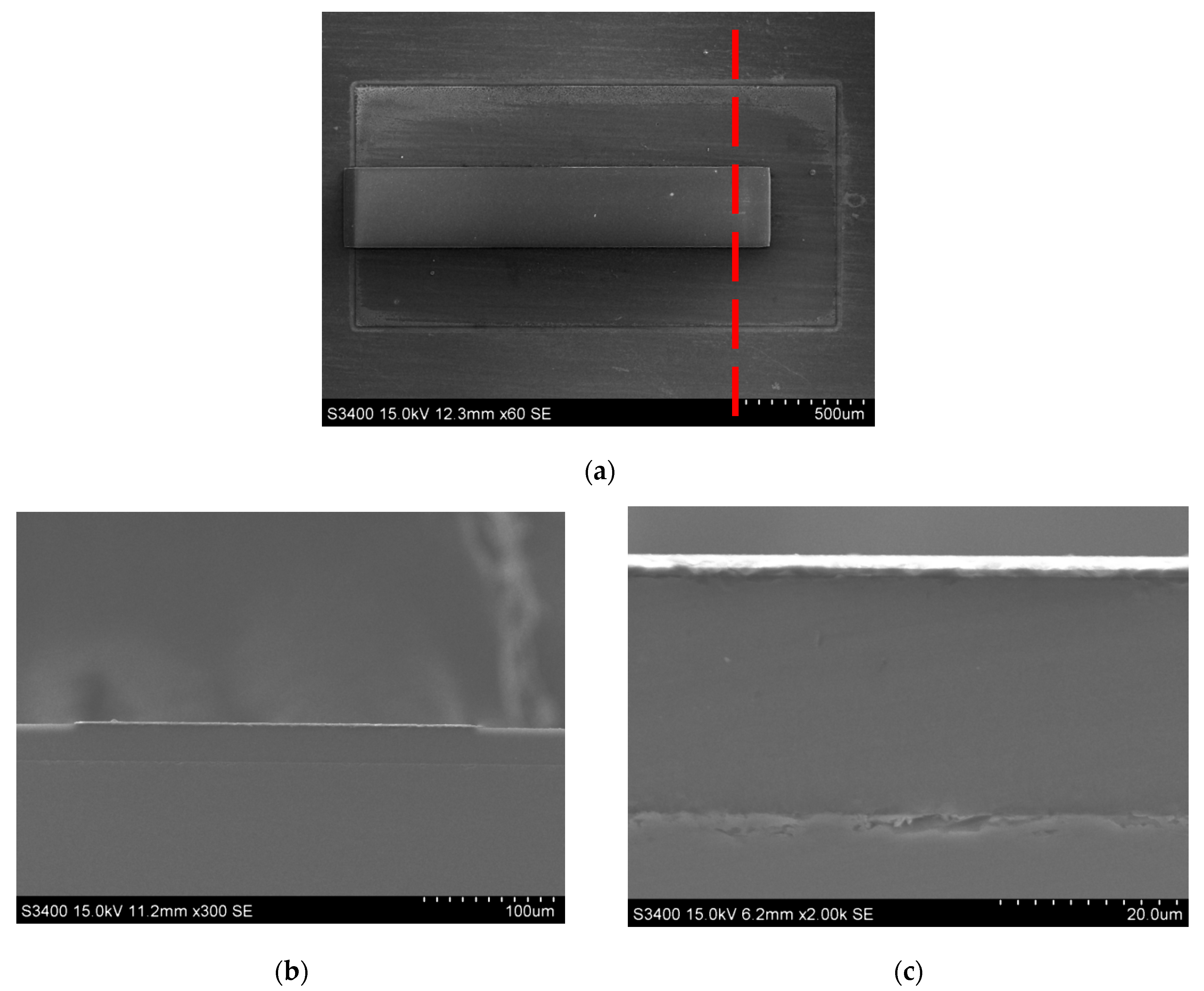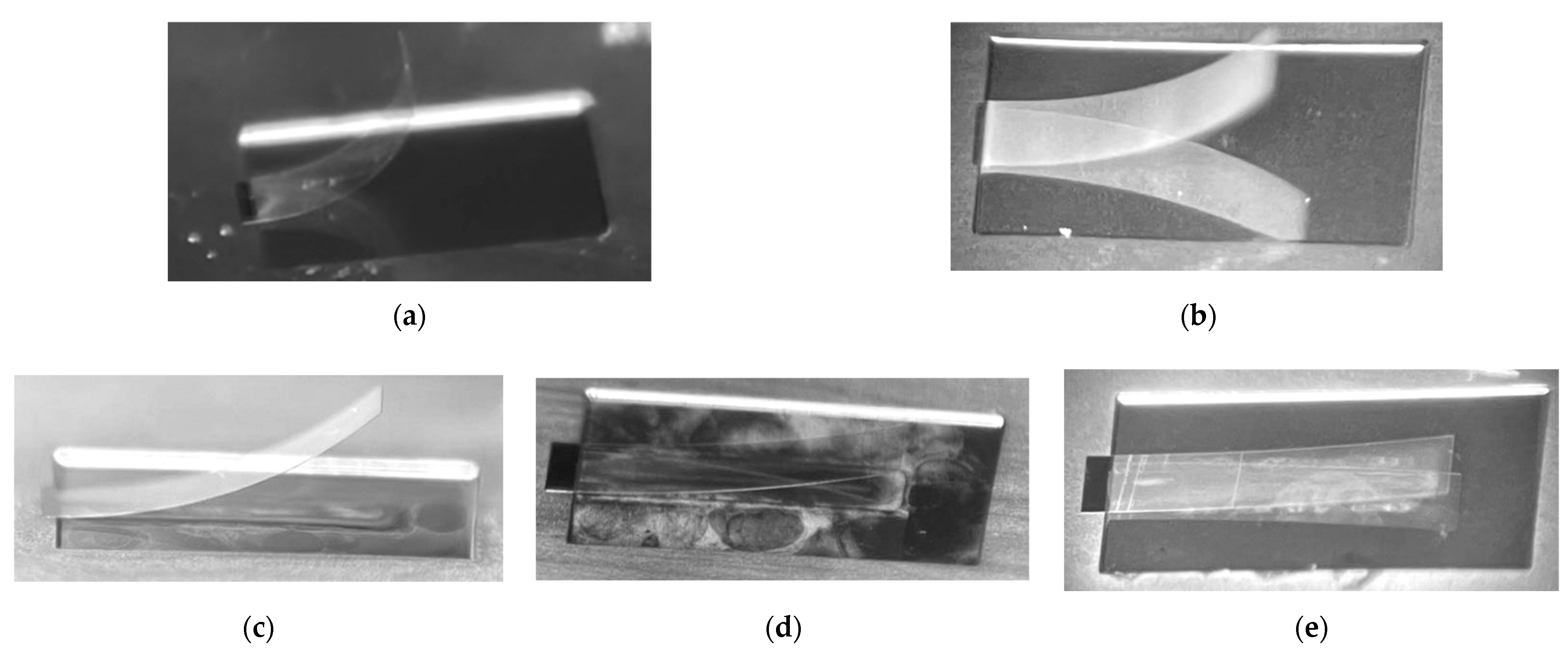Research on Processing Technology of Multi-Layer Heterogeneous Material Composite Micron Cantilever Beam Structure
Abstract
:1. Introduction
2. Theoretical Model of Multi-Layer Heterogeneous Material Composite Cantilever Beam
3. Preparation of Multi-Layer Heterogeneous Material Composite Cantilever Beam
3.1. Experiment Procedure
3.2. Experiment Results
4. Conclusions
Author Contributions
Funding
Conflicts of Interest
References
- López-García, J.; Martín-Palma, R.J. Porous silicon based structures for the electrical biosensing of glucose. Sens. Actuators B Chem. 2006, 45, 336–341. [Google Scholar]
- Kanjilal, A.; Song, M. Observation of room-temperature resonant photoluminescence in porous silicon. Phys. E Low-Dimens. Syst. Nanostruct. 2006, 35, 151–156. [Google Scholar] [CrossRef]
- Canham, L.T. Canham.Silicon quantum wire array fabrication by electrochemical and chemical dissolution of wafers. Appl. Phys. Lett. 1990, 57, 1046–1048. [Google Scholar] [CrossRef]
- Turner, D.R. Electropolishing silicon in hydrofluoric acid solutions. J. Electrochem. Soc. 1958, 105, 402–408. [Google Scholar] [CrossRef]
- Pickering, C.; Robbins, D.J. Optical studies of the structure of porous silicon films formed in p-type degenerate and non-degenerate silicon. J. Phys. C Solid State Phys. 1984, 17, 6535–6552. [Google Scholar] [CrossRef]
- Fuller, C.S.; Ditzenberger, J.A. Diffusion of donor and accepter elements in silicon. J. Appl. Phys. 1956, 27, 544–553. [Google Scholar] [CrossRef]
- Lai, C. Study on Corrosion Behavior of Porous Silicon in Alkaline Solutions; Chongqing University: Chognqing, China, 2014. [Google Scholar]
- Chazalviel, J.N.; Wehrspohn, R.B. Electrochemical preparation of porous semiconductors:from phenomenology to understanding. Mater. Sci. Eng. B 2000, 69, 1–10. [Google Scholar] [CrossRef]
- Lamba, M.; Mittal, N.; Singhet, K. Design Analysis of Polysilicon Piezoresistors PDMS (Polydimethylsiloxane) Microcantilever Based MEMS Force Sensor. Int. J. Mod. Phys. B 2020, 34, 2050072. [Google Scholar] [CrossRef]
- Kaveh, O.; Mahdavi, M. FPGA-Based Characterization and Q-Control of an Active AFM Cantilever. In Proceedings of the 2020 IEEE ASME International Conference on Advanced Intelligent Mechatronics(AIM), Boston, MA, USA, 6–9 July 2020. [Google Scholar]
- Tian, B.; Li, H.; Yang, H. Design and Performance Test of an Ocean Turbulent Kinetic Energy Dissipation Rate Measurement Probe. Micromachines 2018, 9, 311. [Google Scholar] [CrossRef] [PubMed]
- Huang, S.; Zhang, X. Extension of the Stoney formula for film-substrate systems with gradient stress for MEMS applications. J. Micomech. Microeng. 2006, 16, 382. [Google Scholar] [CrossRef]
- Zhang, X.; Zhang, T.; Zohar, Y. Measurements of residual stresses in thin films using micro-rotating-structures. Thin Solid Film. 1998, 335, 97–105. [Google Scholar] [CrossRef]
- Ikehara, T.; Zwijze, R.; Ikeda, K. New method for an accurate determination of residual strain in polycrystalline silicon films by analysing resonant frequencies of micromachined beams. J. Micromech. Microeng. 2001, 11, 55. [Google Scholar] [CrossRef]
- Maier-Schneider, D.; Maibach, J.; Obermeier, E. A new analytical solution for the load-deflection of square membranes. Microeletromech. Syst. 1995, 4, 238–241. [Google Scholar] [CrossRef]
- Oliver, W.C.; Pharr, G.M. An improved technique for determining hardness and elastic modulus using load and displacement sensing indentation experiments. J. Mater. Res. 1992, 7, 1564–1583. [Google Scholar] [CrossRef]
- Paghi, A.; Strambini, L.; Toia Fabrizio, F. Peripheral Nanostructured Porous Silicon Boosts Static and Dynamic Performance of Integrated Electronic Devices. Adv. Electron. Mater. 2020, 6, 2000615. [Google Scholar] [CrossRef]
- Barillaro, G.; Bruschi, P.; Pieri, F. CMOS-compatible fabrication of porous silicon gas sensors and their readout electronics on the same chip. Phys. Status Solidi 2007, 204, 1423–1428. [Google Scholar] [CrossRef]
- Barillaro, G.; Strambini, L.M. An integrated CMOS sensing chip for NO2 detection. Sens. Actuators B Chem. 2008, 134, 585–590. [Google Scholar] [CrossRef]
- Chiara, C.; Giovanni, P.; Kurt, W.K.; Giuseppe, B. Controlled Microfabrication of High-Aspect-Ratio Structures in Silicon at the Highest Etching Rates: The Role of H2O2 in the Anodic Dissolution of Silicon in Acidic Electrolytes. Adv. Funct. Mater. 2017, 27, 1604310. [Google Scholar]
- Margherita, B.; Salvatore, S.; Lucanos, M.S.; Giuseppe, B. Electrochemical micromachining as an enabling technology for advanced silicon microstructuring. Adv. Funct. Mater. 2012, 22, 1222–1228. [Google Scholar]
- Barillaro, G.; Nannini, A.; Piotto, M. Electrochemical etching in HF solution for silicon micromachining. Sens. Actuators A 2002, 102, 195–201. [Google Scholar] [CrossRef]
- Shang, Y.; Zhang, L. Research on processing technology of beam membrance structure based on porous silicon. Mod. Phys. Lett. B 2019, 33, 986. [Google Scholar] [CrossRef]
- Liu, Z.; Shang, Y. Research on micro-cavity structure processing technology based on porous silicon. Mod. Phys. Lett. B 2020, 34, 2050319. [Google Scholar] [CrossRef]







| Material | Thickness (μm) |
|---|---|
| Si | 400 |
| SiO2 | 1 |
| SiNx | 1 |
| Al | 0.2 |
| Piezoelectric | 0.2 |
| Sample | Process Conditions | |
|---|---|---|
| SiO2 Film Thickness (μm) | SiNx Film Thickness (μm) | |
| 1# | 1.25 | 0.75 |
| 2# | 1 | 1 |
| 3# | 0.75 | 1.25 |
| 4# | 0.5 | 1.5 |
| 5# | 0.25 | 1.75 |
Publisher’s Note: MDPI stays neutral with regard to jurisdictional claims in published maps and institutional affiliations. |
© 2022 by the authors. Licensee MDPI, Basel, Switzerland. This article is an open access article distributed under the terms and conditions of the Creative Commons Attribution (CC BY) license (https://creativecommons.org/licenses/by/4.0/).
Share and Cite
Shang, Y.; Zhang, H.; Wu, Z.; Chen, D.; Wu, S. Research on Processing Technology of Multi-Layer Heterogeneous Material Composite Micron Cantilever Beam Structure. Micromachines 2022, 13, 144. https://doi.org/10.3390/mi13020144
Shang Y, Zhang H, Wu Z, Chen D, Wu S. Research on Processing Technology of Multi-Layer Heterogeneous Material Composite Micron Cantilever Beam Structure. Micromachines. 2022; 13(2):144. https://doi.org/10.3390/mi13020144
Chicago/Turabian StyleShang, Yingqi, Hongquan Zhang, Zuofei Wu, Dongsa Chen, and Shuangyu Wu. 2022. "Research on Processing Technology of Multi-Layer Heterogeneous Material Composite Micron Cantilever Beam Structure" Micromachines 13, no. 2: 144. https://doi.org/10.3390/mi13020144





